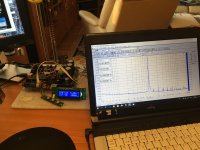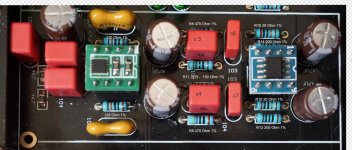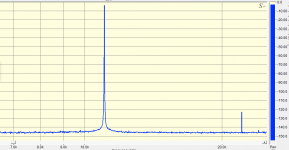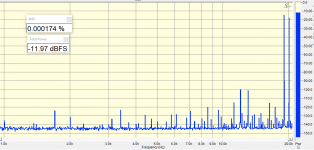jlw,
very good looking
what are smd op amps that you upgrade
did you think to change I/V and next stage filter resistors to a better quality ones
also what type Wima are you using for 100 p film caps, anyone tried polysterene here?
did you try Nichicon bipolar Instead of KZ after regulator
very good looking
what are smd op amps that you upgrade
did you think to change I/V and next stage filter resistors to a better quality ones
also what type Wima are you using for 100 p film caps, anyone tried polysterene here?
did you try Nichicon bipolar Instead of KZ after regulator
My not-too-adulterated board as it stands.
The biggest improvement was junking all the 47uF lytics around the OpAmps replacing them with 10uF film and upping the 220uF at the output of the regulator for +/- rail with 330uF Nichicon KZ.
The tonal balance of the unit completely changed from lean to lush. Smooth with a lot more microdynamics.
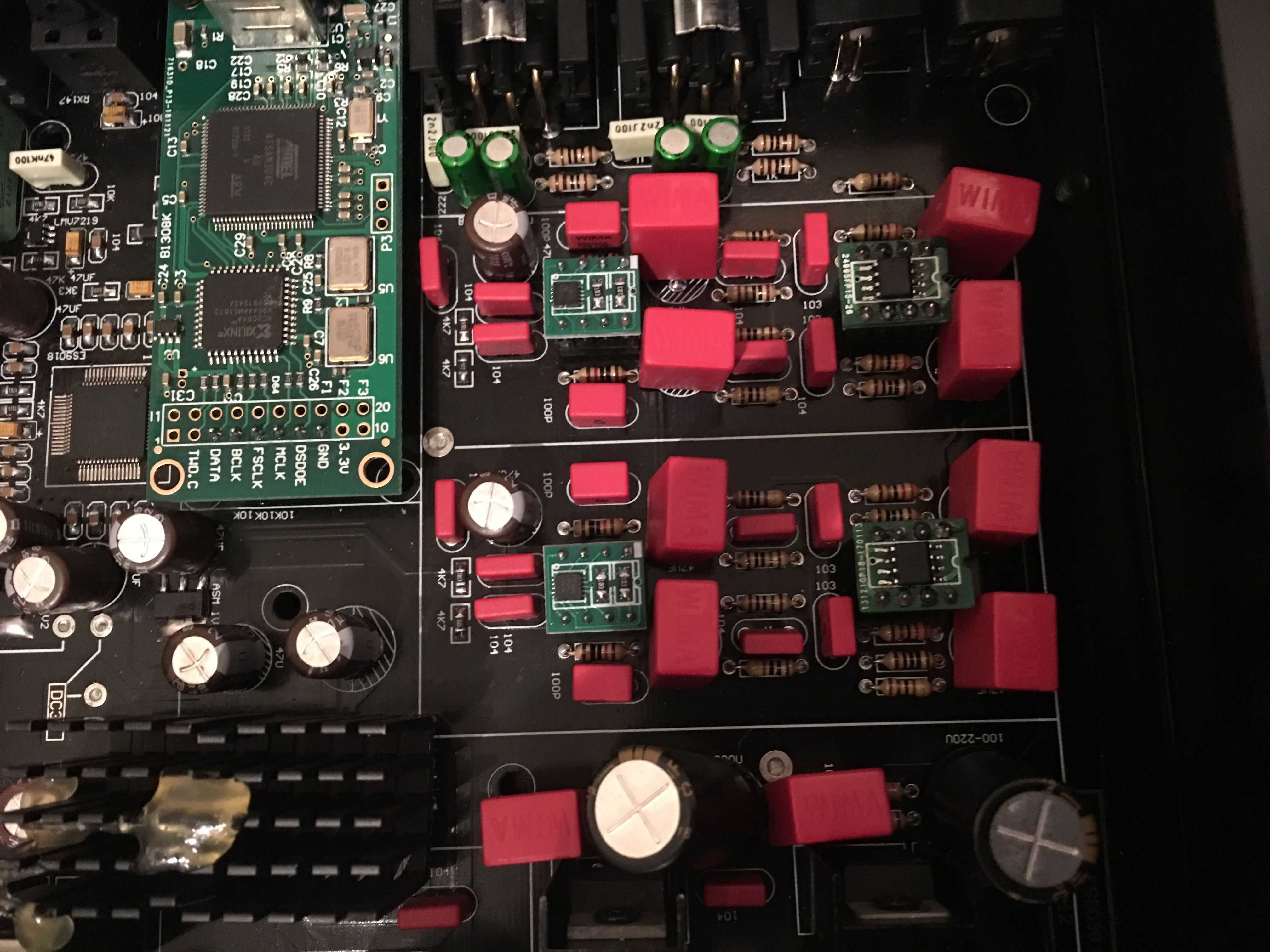
What opamps do you use on it?
1622 for the first stage and 1611 for the second. Current is a concern for the 9038 vs 9018.
Cant use bipolar right outside the regulator its +15 one phase and -15 another phase.
Resistors... I "think" the stock ones are carbon film. Good enough for me I dont want to sink $ into Naked Vishays after all its not phono.
The 100pF ones are stock I dont think they are fake.
Cant use bipolar right outside the regulator its +15 one phase and -15 another phase.
Resistors... I "think" the stock ones are carbon film. Good enough for me I dont want to sink $ into Naked Vishays after all its not phono.
The 100pF ones are stock I dont think they are fake.
1
Resistors... I "think" the stock ones are carbon film. Good enough for me I dont want to sink $ into Naked Vishays after all its not phono.
0.1% metal film is a must for the output stage. at least i/v fb one.
stock values for i/v and LPF are not optimal as well.
not so expensive imho
My not-too-adulterated board as it stands.
The biggest improvement was junking all the 47uF lytics around the OpAmps replacing them with 10uF film and upping the 220uF at the output of the regulator for +/- rail with 330uF Nichicon KZ.
The tonal balance of the unit completely changed from lean to lush. Smooth with a lot more microdynamics.
Your description of the effect of adding the relatively large (in terms of capacitance) film caps to bypass the power rails fits what I experienced very well. In the last few months, I have tried adding various combinations of large PP film caps to the power rails of my 9038Pro board. "Lush" and "smooth" were two adjectives that came to mind when I listened to the DAC board with the added film capacitors.
Ultimately, however, I have decided to remove all the film caps, and even the 0.1uF X7R bypassing caps I also added, from the board. The reason is that I am not convinced that "lushness" or "smoothness" corresponds to better sound quality. For instance, I don't think I've ever heard a female or male voice in real life that is "lush," "smooth," "warm," or "rounded"in the way presented by the DAC with large bypass film caps. I can see that some people may prefer/enjoy the "lush" or "smooth" sound, but to me such sound is not closer to reality than the dry lean sound of the board without the film cap bypassing.
Instead of trying to hi-jack this thread, I'll pose my question regarding the wisdom of using large film bypass caps in another thread (likely in the analogue line-level forum).
The reason is that I am not convinced that "lushness" or "smoothness" corresponds to better sound quality. For instance, I don't think I've ever heard a female or male voice in real life that is "lush," "smooth," "warm," or "rounded"in the way presented by the DAC with large bypass film caps.
(1) Film caps can help fix one problem with dacs, but they are not a band-aid to use instead of fixing other things that also need some work.
(2) Most records are not recorded with the intention of sounding real, rather they are intended to sound better than real, and that often (but not always) includes a certain amount of added smoothness and lushness. The only true exception would be for things such as classical music recorded live with only two condenser mics. Recordings of that type are intended to capture reality as close as recording technology allows.
exactly.Most records are not recorded with the intention of sounding real, rather they are intended to sound better than real, and that often (but not always) includes a certain amount of added smoothness and lushness. The only true exception would be for things such as classical music recorded live with only two condenser mics. Recordings of that type are intended to capture reality as close as recording technology allows.
Most of the music I listen to is heavily processed and will never resemble real life but the result of adding the large PP film seemed more accurate, that there was more data from original recording making it through, aswell as soundning more pleasant of course
My reference material is 70% classical 30% jazz, many SACDs. My system and room (Avalon Eidolon Diamond) have a tendency to get lean so this mod config works out for me.
Let me clarify that I am not bypassing with "large film caps".
The original config is 220uF lytic + 47uF lytic x 4 (they are electrically in parallel just each one close to + or - pin of the OpAmp)
I am just replacing the 220uF lytic with a high grade 330uF KZ (lytic) and replacing the 47uF lytic "Elnas" with 10uF fiim (thats lower value than the 47uF stock), and adding small 0.1uF bypass.
I am trying to get the bypass to be as close to 1/100th the primary cap as possible.
Let me clarify that I am not bypassing with "large film caps".
The original config is 220uF lytic + 47uF lytic x 4 (they are electrically in parallel just each one close to + or - pin of the OpAmp)
I am just replacing the 220uF lytic with a high grade 330uF KZ (lytic) and replacing the 47uF lytic "Elnas" with 10uF fiim (thats lower value than the 47uF stock), and adding small 0.1uF bypass.
I am trying to get the bypass to be as close to 1/100th the primary cap as possible.
actually, ESS has ceramic arrays on the demo board. see also:
C0G/NP0 Parallel-Capacitor-Board
C0G/NP0 Parallel-Capacitor-Board
Attachments
I spoke with Richard from Sonic imagery labs about my I/V stage
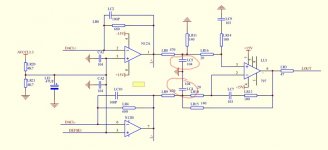
Here is what he wrote

Here is what he wrote
Hello, C4 and C5 are probably not needed, C7 should probably be parallel with either R15 or R12. R16, R12 R10 R15 R14 are all quite small. With such low resistance, the tolerance error and thermal gradients will become noticable and ruin the CMRR of U1.
I would increase those values by at least 10X and reduce the caps by /10
so far i have removed C4 and C4 and this seem to add some detail to sound/. Could someone give it a try?
I would increase those values by at least 10X and reduce the caps by /10
so far i have removed C4 and C4 and this seem to add some detail to sound/. Could someone give it a try?
c4/c5 are part of LPF, for the R values see China ES9018PRO ES9028PRO 9038PRO mods&upgrades
or you can check out ES9038Q2M board thread and try R/C values Mark is recommending
or you can check out ES9038Q2M board thread and try R/C values Mark is recommending
Last edited:
ok, that is it. SNR over 120db, THD below 0.0001, the highest harmonic about -130dB.
putting the thing in a box. hope will have a chance to compare with an oppo udp205 soon.
and starting another es9028pro. this time certainly with register tweaking, galvanic isolation etc.
putting the thing in a box. hope will have a chance to compare with an oppo udp205 soon.
and starting another es9028pro. this time certainly with register tweaking, galvanic isolation etc.
Attachments
Last edited:
ok, that is it. SNR over 120db, THD below 0.0001, the highest harmonic about -130dB.
putting the thing in a box. hope will have a chance to compare with an oppo udp205 soon.
and starting another es9028pro. this time certainly with register tweaking, galvanic isolation etc.
Pretty impressive result, well done.
Is this with or without harmonic correction?
What are you using for measurement ADC, at these levels, the ADC will come into play WRT it's own linearity.
T
thanks, no harmonic correction is done at this point.
the ADC used was Olivine-2 OLIVINE ADC - ALTOR AUDIO
the ADC used was Olivine-2 OLIVINE ADC - ALTOR AUDIO
R14, R10 from R200 to ?? (I couldn't find out what to do with)
you mean R14/R12? put just jumpers
thanks, no harmonic correction is done at this point.
the ADC used was Olivine-2 OLIVINE ADC - ALTOR AUDIO
So it looks like you are exceeding the spec of the Olivene-2.
I think the only way to really know what the DAC is doing is to use a notch filter which mostly takes ADC own harmonics out of the equation.
Still, it's a very good result regardless.
T
yes, a notch filter would boost the sensitivity indeed. regarding Olivine2, the stated noise floor is below -140db, what actually I get. as for the harmonics, so far I know they were measured with Victors oscillator, powered from an adapter, which may add some. the DAC measured above was powered using Imed power supply + Isobar 60dB filter. got them from a scrapyard when the local hospital was upgrading equipment🙂
anyway, Olivine was the second best investment for this audio madness, next to Siglent SDS1202X-E
anyway, Olivine was the second best investment for this audio madness, next to Siglent SDS1202X-E
ok, that is it. SNR over 120db, THD below 0.0001, the highest harmonic about -130dB.
putting the thing in a box. hope will have a chance to compare with an oppo udp205 soon.
and starting another es9028pro. this time certainly with register tweaking, galvanic isolation etc.
I can see you are back to EL caps for the I/V stage?
never cared to remove them. fake or real these read Silmic II 100uF. measure pretty much like stated. one may try without them, anyway some bypassing needed close to the power pins.
some more measurements: jitter estimation with a 11025Hz test tone shows no visible spurs, just the second harmonic. IMD for 19/20kHz tones is present, but 0.000174% is still about -115dB. I suppose this is not bad, but perhaps there might be something to improve.
some more measurements: jitter estimation with a 11025Hz test tone shows no visible spurs, just the second harmonic. IMD for 19/20kHz tones is present, but 0.000174% is still about -115dB. I suppose this is not bad, but perhaps there might be something to improve.
Attachments
- Home
- Source & Line
- Digital Line Level
- China ES9018PRO ES9028PRO 9038PRO mods&upgrades

